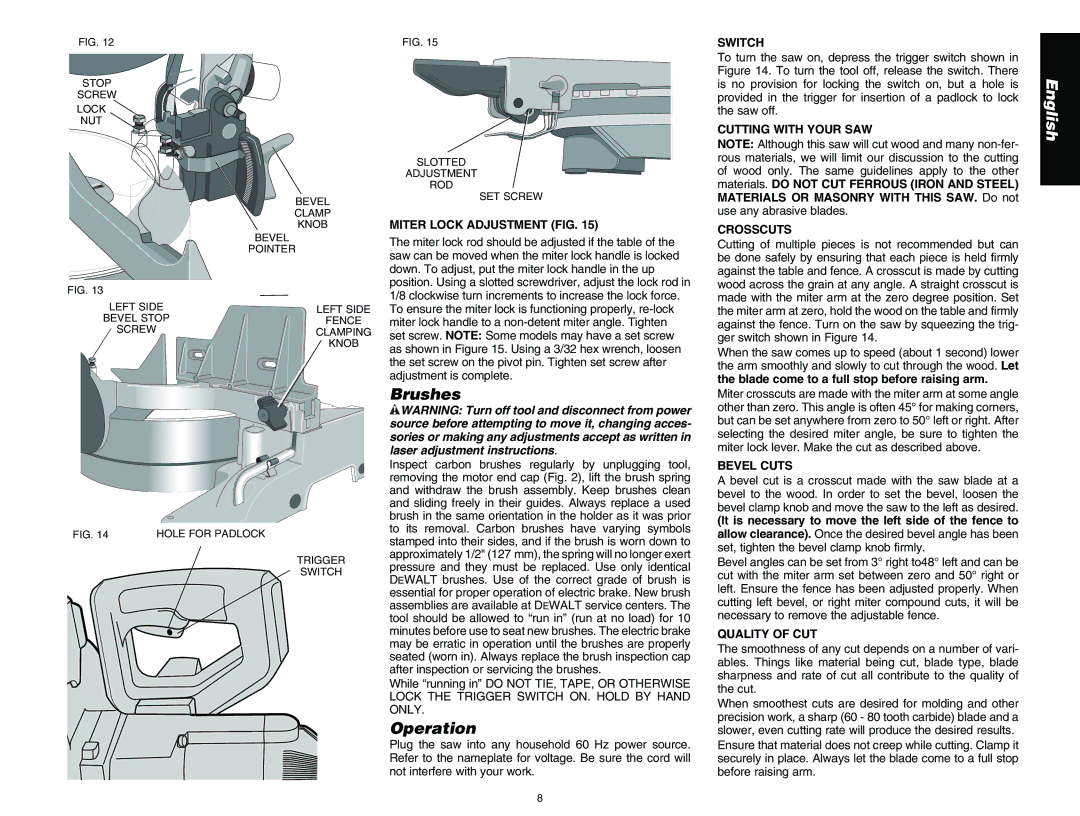
FIG. 12
STOP
SCREW
LOCK
NUT
| BEVEL |
| CLAMP |
| KNOB |
| BEVEL |
| POINTER |
FIG. 13 |
|
LEFT SIDE | LEFT SIDE |
BEVEL STOP | FENCE |
SCREW | CLAMPING |
| KNOB |
FIG. 14 | HOLE FOR PADLOCK |
TRIGGER
SWITCH
FIG. 15
SLOTTED
ADJUSTMENT
ROD
SET SCREW
MITER LOCK ADJUSTMENT (FIG. 15)
The miter lock rod should be adjusted if the table of the saw can be moved when the miter lock handle is locked down. To adjust, put the miter lock handle in the up position. Using a slotted screwdriver, adjust the lock rod in 1/8 clockwise turn increments to increase the lock force. To ensure the miter lock is functioning properly,
Brushes
![]() WARNING: Turn off tool and disconnect from power source before attempting to move it, changing acces- sories or making any adjustments accept as written in laser adjustment instructions.
WARNING: Turn off tool and disconnect from power source before attempting to move it, changing acces- sories or making any adjustments accept as written in laser adjustment instructions.
Inspect carbon brushes regularly by unplugging tool, removing the motor end cap (Fig. 2), lift the brush spring and withdraw the brush assembly. Keep brushes clean and sliding freely in their guides. Always replace a used brush in the same orientation in the holder as it was prior to its removal. Carbon brushes have varying symbols stamped into their sides, and if the brush is worn down to approximately 1/2" (127 mm), the spring will no longer exert pressure and they must be replaced. Use only identical DEWALT brushes. Use of the correct grade of brush is essential for proper operation of electric brake. New brush assemblies are available at DEWALT service centers. The tool should be allowed to “run in” (run at no load) for 10 minutes before use to seat new brushes. The electric brake may be erratic in operation until the brushes are properly seated (worn in). Always replace the brush inspection cap after inspection or servicing the brushes.
While “running in” DO NOT TIE, TAPE, OR OTHERWISE LOCK THE TRIGGER SWITCH ON. HOLD BY HAND ONLY.
Operation
Plug the saw into any household 60 Hz power source. Refer to the nameplate for voltage. Be sure the cord will not interfere with your work.
SWITCH
To turn the saw on, depress the trigger switch shown in Figure 14. To turn the tool off, release the switch. There is no provision for locking the switch on, but a hole is provided in the trigger for insertion of a padlock to lock the saw off.
CUTTING WITH YOUR SAW
NOTE: Although this saw will cut wood and many
CROSSCUTS
Cutting of multiple pieces is not recommended but can be done safely by ensuring that each piece is held firmly against the table and fence. A crosscut is made by cutting wood across the grain at any angle. A straight crosscut is made with the miter arm at the zero degree position. Set the miter arm at zero, hold the wood on the table and firmly against the fence. Turn on the saw by squeezing the trig- ger switch shown in Figure 14.
When the saw comes up to speed (about 1 second) lower the arm smoothly and slowly to cut through the wood. Let the blade come to a full stop before raising arm.
Miter crosscuts are made with the miter arm at some angle other than zero. This angle is often 45° for making corners, but can be set anywhere from zero to 50° left or right. After selecting the desired miter angle, be sure to tighten the miter lock lever. Make the cut as described above.
BEVEL CUTS
A bevel cut is a crosscut made with the saw blade at a bevel to the wood. In order to set the bevel, loosen the bevel clamp knob and move the saw to the left as desired.
(It is necessary to move the left side of the fence to allow clearance). Once the desired bevel angle has been set, tighten the bevel clamp knob firmly.
Bevel angles can be set from 3° right to48° left and can be cut with the miter arm set between zero and 50° right or left. Ensure the fence has been adjusted properly. When cutting left bevel, or right miter compound cuts, it will be necessary to remove the adjustable fence.
QUALITY OF CUT
The smoothness of any cut depends on a number of vari- ables. Things like material being cut, blade type, blade sharpness and rate of cut all contribute to the quality of the cut.
When smoothest cuts are desired for molding and other precision work, a sharp (60 - 80 tooth carbide) blade and a slower, even cutting rate will produce the desired results. Ensure that material does not creep while cutting. Clamp it securely in place. Always let the blade come to a full stop before raising arm.
English
8
